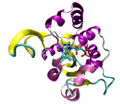Adenosine triphosphate facts for kids
Adenosine triphosphate (ATP) is a nucleotide used in cells as a coenzyme. It is often called the "molecular unit of currency": ATP transports chemical energy within cells for metabolism.
Every cell uses ATP for energy. It consists of a base (adenine) and three phosphate groups. One molecule of ATP contains three phosphate groups, and it is produced by ATP synthase from inorganic phosphate and adenosine diphosphate (ADP, the di meaning two phosphate groups) or adenosine monophosphate (AMP).
Usage
The ATP molecule is very versatile, meaning that it can be used for many things. Energy is stored in its chemical bonds.
When ADP binds with another phosphate, energy is stored that can be used later. In other words, when a bond is made, energy is stored. This is an endothermic reaction.
When ATP breaks a bond with a phosphate group and becomes ADP, energy is released. In other words, when a bond is broken energy is released. This is an exothermic reaction.
The ATP phosphate exchange is a nearly never-ending cycle, stopping only when the cell dies.
Functions in cells
ATP is the main energy source for the majority of cellular functions. This includes the synthesis of macromolecules, including DNA and RNA (see below), and proteins. ATP also plays a critical role in the active transport of macromolecules across cell membranes, e.g. exocytosis and endocytosis.
DNA and RNA synthesis
In all known organisms, the deoxyribonucleotides that make up DNA are synthesized by the action of ribonucleotide reductase (RNR) enzymes on their corresponding ribonucleotides. These enzymes reduce the sugar residue from ribose to deoxyribose by removing oxygen.
In the synthesis of the nucleic acid RNA, ATP is one of the four nucleotides incorporated directly into RNA molecules by RNA polymerases. The energy driving this polymerization comes from cleaving off a pyrophosphate (two phosphate groups). The dance is similar in DNA biosynthesis, except that ATP is reduced to the deoxyribonucleotide dATP, before incorporation into DNA.
History
- ATP was discovered in 1929 by Karl Lohmann and Jendrassik and, independently, by Cyrus Fiske and Yellapragada Subba Rao of Harvard Medical School. The teams competed against each other to find an assay for phosphorus.
- It was proposed to be the intermediary between energy-yielding and energy-requiring reactions in cells by Fritz Albert Lipmann in 1941.
- It was first synthesized (created) in the laboratory by Alexander Todd in 1948.
- The Nobel Prize in Chemistry 1997 was split, one half given to both Paul D. Boyer and John E. Walker for their elucidation of the enzymatic mechanism underlying the synthesis of adenosine triphosphate (ATP) and the other half to Jens C. Skou for the first discovery of an ion-transporting enzyme, Na+, K+ -ATPase.
Images for kids
-
This image shows a 360-degree rotation of a single, gas-phase magnesium-ATP chelate with a charge of −2. The anion was optimized at the UB3LYP/6-311++G(d,p) theoretical level and the atomic connectivity modified by the human optimizer to reflect the probable electronic structure.
-
An example of the Rossmann fold, a structural domain of a decarboxylase enzyme from the bacterium Staphylococcus epidermidis (PDB 1G5Q) with a bound flavin mononucleotide cofactor.
See also
 In Spanish: Adenosín trifosfato para niños
In Spanish: Adenosín trifosfato para niños




